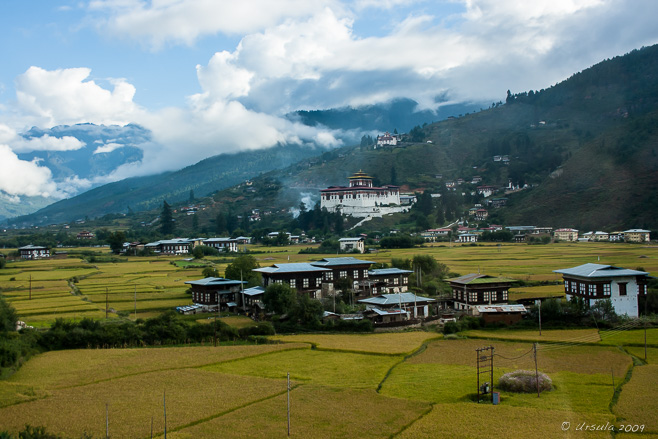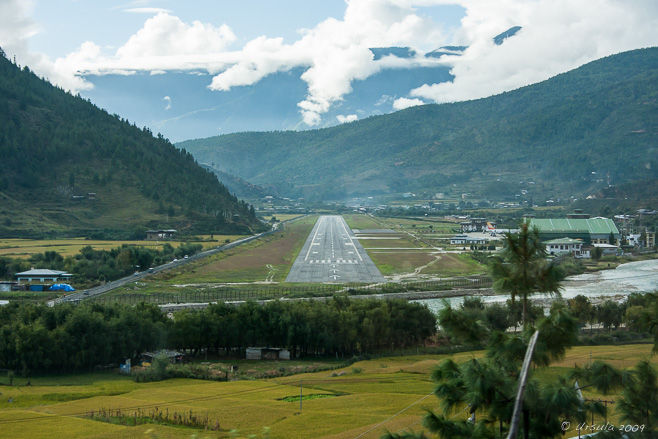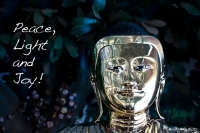.jpg)
Prayers on the Wind
Dochula Pass, Bhutan, 3150 metres above sea level, is home to 108 chortens (stupas) and countless prayer flags.
Bhutan, that once-secretive, still-exotic, Himalayan Kingdom, is a sensory feast for the photographic enthusiast.
The story that tourist numbers are strictly limited is over-stated. But, they are self-limited by the fact that, other than Indian nationals, all foreigners need to arrive by air – and for a long time only Drukair flew in and out. Today Druk has five airplanes, but when I visited – back in September 2009 as part of a group with photographers Gavin Gough and Jackie Rado – they had only two A319 Airbuses.
This helps explain why our trip started with a long day inside Bangkok’s Suvarnabhumi Airport. We arrived for our group check-in at 4:20am, only to be told that our plane (one of the two at the time) had “technical problems” and there would be a “slight” delay as we waited for parts to come from France.
Flights into Paro, Bhutan’s only international airport, are by visual flight rules (VFR), meaning they are dependent on weather and daylight. Only a few aircraft, in the hands of skilled pilots, can fly through the angled mountain passes and land safely on the short runway. Landing or taking off in the dark is not an option.
So, as the “slight” delay extended past breakfast, and then past lunch, we sat in an airport coffee shop – eight photographers with over-sized carry-ons and laptop cables tangled towards every available wall outlet – waiting for word, and knowing that if we didn’t leave by early afternoon, we’d go nowhere until morning. Our plane finally left at 3:00pm.
The flight into the Paro Valley, with the Himalaya rising on all sides, was everything it was cracked up to be. Now that you no longer have to dip your wing to people eating dinner in their high-rise apartments in Hong Kong, there can’t be many international airports like Paro. We were blessed with sun and good visibility, and were therefore able to watch as the plane took two sharp turns through the tight valley and descended to the airport. The collective intake of breath as the left wing almost touched the mountainside was palpable, and the passengers burst into spontaneous applause when the wheels touched safely down on the runway.
Our first full day in the country was spent hiking to Tiger’s Nest, high over the Paro Valley. Then it was time to hop in a minibus, and cross some of the rugged countryside – under clear, sunny Autumn skies – in search of the famous Tibetan Buddhist festivals, or tsechus (Dzongkha: ཚེས་བཅུ།, literally “day ten”), where we would photograph the swirling and stomping dancers (e.g.: Wangduephodrang Dzongkhag Dzong Tshechu).
Getting there was part of the wonder. I absolutely loved the mountains, and I sat in the bus with my nose pressed to the glass for most of our journey from Paro to Wangduephodrang.
But it was the prayer flags that really entranced me: I couldn’t get enough of them.

Morning Mists in the Paro Valley
You could be nowhere else! The architecture around Paro reflects Bhutan’s traditional architectural style – which is actually codified in official guidelines.

Paro International Airport
Surrounded by magnificent mountains as high as 5,500 m (18,000 ft), Paro Airport (2,235 m / 7,332 ft) is considered one of the world’s most challenging.

Roadside Stop
Our first stop on the road was at the Chuzom (or Chhuzom). A chu is a river; zom means join.

The Chuzom
This is the place where Paro and Wong (Thimphu) Rivers meet. Traditional Bhutanese consider this an inauspicious union of a father and mother river, …

Three Stupas
… so there are three stupas (chortens) here to ward off evil spirits. As if to cover all bases, the stupas are Bhutanese, Nepali, and Tibetan in style.

View from the MiniVan
I watch out the windows of the van as we continue to climb over the Thimphu River.

Grandma on the Ridge
Above the Ola Rong Chu, we stop on a ridge where I chat with a grandmother who is caring for some of her many grandchildren while their parents work.

Semtokha Dzong
On the other side of the Ola Rong Chu Valley, Semtokha Temple nestles in the trees.

Grandma and the Kids

Border Guard
Bhutan is partitioned into a number of divisions – so we go through several checkpoints on our drives.

Churpi or Chugui
A popular Bhutanese snack, chhurpi (churpi) is a traditional dried and smoked cheese made from yak milk.

Prayers over the Mountains
Our next stop is at the popular Dochu La Chorten, a 3150 metre-high mountain pass with 360° views over the Himalayan mountains.

Tangled Prayers and Dreams

Whispered Prayers

“Yellow is for the Earth”
According to legend, prayer flags started from the battle flags used by the Gautama Buddha against the evil asuras. The five flag colors represent the five elements: blue for the sky and space, white for air and wind, red for fire, green for water, and yellow for the earth.

Forever Prayers

Faint Prayers

Druk Wangyal Chortens
The Bhutanese Queen Mother commissioned 108 chortens at Dochula Pass in memory of Bhutanese soldiers killed in the 2003 war against Indian insurgents.

Stairs up Dochu La Chorten

Tradesman on the Roof

Mists on the Pass

Bhutanese Driver

“Oṃ maṇi padme hūṃ”
Expresions of Buddhist worship are everywhere in Bhutan.

The ever-present prayer flags, the chorten and stupa dotted around the countryside, and the prayer texts; all around Bhutan there are reminders to honour Buddhist practice.
Not a bad way to live!
‘Till next time.
Pictures: 25September2009



.jpg)

























.png)
.png)


[…] by Indian mythology to be enemies of the gods. Ubiquitous in the Tibetan Buddhist world (e.g.: Prayers on the Wind: Bhutan), prayer flags come in different styles and shapes, but the most commonly seen are the Lungta […]